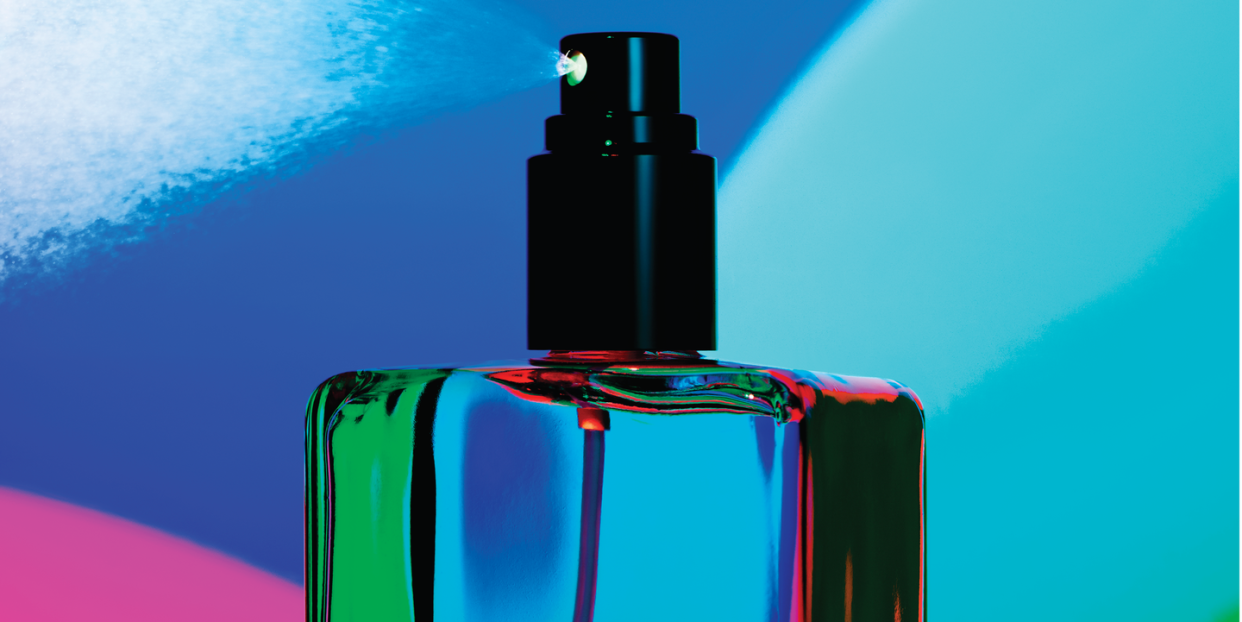Your Favorite Scent May Have Been Created By a Computer

Perfumers often use analogies to describe their craft. Calice Becker, the nose behind Dior’s famous J’adore, likens her work to that of an architect. Stephen Nilsen, who created Vera Wang Lovestruck, thinks of it as writing music: He groups single fragrance notes into chords—or accords, as they’re called in the business—and arranges a finished composition. Francis Kurkdjian believes perfumery, at its heart, is storytelling. And that may be one reason he’s wary of a recent development in fragrance: the use of artificial intelligence.
On a recent Friday evening, the cofounder of Maison Francis Kurkdjian calls from a Paris café to explain. Oui, he knows of several fragrance companies that use AI. And oui, he’s smelled some of those creations. He remains unimpressed. “So far, I haven’t seen anything unusual, daring, or striking,” he says. “Without the human, all you get is a blend.” Another analogy: “If you told a machine you like blue, red, and pink, and then you asked the machine [for a painting], you would never get a Mondrian!”
But what if an AI-created perfume could be more than a simple blend? In 2017, the Brazilian cosmetics company O Boticário decided to find out. It approached IBM Research to help design two perfumes using only artificial intelligence. The idea was gimmicky, sure, but O Boticário thought a tech-forward creation might appeal to millennials.
At the time, IBM Research lacked data about fragrance, so it tapped a German fragrance house, Symrise—which has a database of over 1.8 million aroma formulas for everything from perfumes to toothpaste flavors—to help build a program that could teach itself how to compose fragrances. “We called it Philyra, after the Greek goddess of perfume,” says David Apel, a Symrise senior perfumer who worked on the venture.
Once Philyra was up and running, the team refined the algorithm by layering in “success criteria,” such as what’s popular in the market. But the additional intel didn’t simplify matters: Philyra was still spitting out thousands of potential formulas. “We had to feed her some seeds,” says Apel, as if talking about a beloved pet. The “seeds” included types of perfumes that were popular with younger customers in Brazil. That reduced the output to a thousand options, including 12 top choices. Apel reviewed the formulas line by line, ordering samples of ones that looked promising. “At one point, I recognized [Philyra] was developing a very nice fougère structure,” he says, using the industry term for herbaceous, mossy scents. “Then I watched Philyra change the citrus and aromatics, and try out combinations in the same way a perfumer would—if you had all the time in the world.” He was, in essence, watching a machine do his job. Rather than feeling threatened, Apel says he was hooked. “I saw an evolution, like watching a young perfumer at work. It was remarkable.”
Because Philyra wasn’t programmed with tradition or emotion, it never had a mentor to instill “the way things are done.” For example, it selected fenugreek seed, which perfumers often avoid because it’s tricky to work with, as well as a frothy, milklike aroma from Symrise’s flavor division. “I wasn’t even aware of the note,” Apel says. “When I saw that happen, it really hit me: This was a unique approach.” O Boticário tested the AI fougère and ended up bottling it. The scent, called Egeo on You, launched in 2019, along with a machine-made feminine counterpart called Egeo on Me. If the number of Brazilian vloggers talking about it on YouTube is any indication, the scents were a hit.

But would it be possible for a computer—or a human, for that matter—to design a perfume that’s universally beloved? Unlikely. Even if an AI program were able to factor in all of humanity’s unique preferences and arrive at a few “most-liked” notes, it wouldn’t be able to blend them into a scent completely autonomously. As experts working with AI are quick to point out, it’s the interaction between human and machine that drives the creative process. “It’s something we use. It doesn’t use us,” Apel says.
That said, data-driven innovation is hot in fragrance right now. Last year, the Swiss fragrance and flavor developer Givaudan launched a system called Carto, which Becker, one of the house’s lead perfumers, compares to the CAD programs architects use to render designs. It’s beautiful to see it in action. When Nilsen, a Givaudan senior perfumer, selects aromas from Givaudan’s database, they appear on a large touch screen as colorful circles, which he can arrange and resize. Then the software works out the math, adjusting the amounts of each note so the potency is balanced. At the moment, Carto doesn’t have a feedback loop to learn and grow, as some AI algorithms do, but what it lacks in sentience it makes up for in efficiency. The touch screen is linked to a robotic compounding machine that can whip up samples in seconds. “It’s amazing, because you don’t have to do as many trials and use up the oil for the samples and the bottles,” Becker explains. “For example, before Carto, it may have taken me a hundred trials to create a muguet note—but now, with Carto, it takes one.”
Like many other consumer companies, the fragrance industry is coming to terms with its environmental impact. Producing perfume uses natural raw resources and creates greenhouse gases and chemical waste, and the finished products are a major source of air pollution. (Volatile chemical products, including perfume, contribute as much air pollution as petroleum emissions from vehicles, according to a study published in Environmental Science and Technology in 2018.) One example of progress can be found at Firmenich, another Swiss fragrance house. Its AI program, Muse, can reengineer a formula to make it more eco-friendly, explains Odile Pelissier, Firmenich’s vice president of creation, development, and innovation. If, say, a formula calls for a large dose of sandalwood oil, which is currently under threat in many countries, the tool’s data might suggest substituting DreamWood, a proprietary natural compound genetically engineered to have a similar smell.
But just because more fragrance developers are using AI doesn’t mean you’ll hear about it. Pelissier explains that some Firmenich clients don’t want to publicize that their perfumes were created with AI. “Fragrance is about emotion, and it has a very intimate human quality,” she says. “Some consumers don’t want a thing created by a machine touching their skin.”
Some innovators are more open. Sommelier du Parfum puts an AI-driven tool in the hands of customers, literally, with its smartphone app. Log in, answer personality questions, share the names of fragrances you already wear, and a chatbot will suggest new scents you might like. (A sample box of five costs $15.)
The Dutch brand Algorithmic Perfumery takes things a step further, letting customers create bespoke perfumes with an AI-driven computer program and a special “fragrance printer” located in Breda, Netherlands. In February, the brand hosted an event at the Ace Hotel in New York City, where it re-created its lab in miniature. Along one wall, the team set up an 11-foot-long version of the printer, featuring 38 large glass ports filled with liquid aromas—some clear as water, others ranging from pale yellow to dark amber—suspended above a convey-or belt wired to a computer.
On a busy Saturday at the start of New York Fashion Week, Stephanie Roccia, 42, was one of the first customers in line to try the program. She pulled up the Algorithmic Perfumery website on her smartphone and got to work on the first step, a questionnaire to rate her personality traits (realist versus dreamer, intuitive versus analytical). Next, she stepped over to a display of seven perfumes to evaluate her preferences and assess how she perceived these scents. As she plugged in her responses, the program collected data to look for patterns: Were more-analytical people fond of woodsy aromas? Did dreamers tend toward citrus? Were young women as enamored with fruity florals as marketers would have you believe?
When she was finished, the program combined the results to create three sample fragrances it thought Roccia might like. She watched a small glass vial travel along the conveyor belt, stop-ping beneath a dozen or so ports to collect droplets. In five minutes, she had her samples.
Would one become her absolute favorite perfume of all time? That might be the wrong question to ask. Algorithmic Perfumery’s cofounder and head of scent creation, Anahita Mekanik, says the goal isn’t to simplify perfume shopping or mechanize the creation process—or even to match every human with a signature scent. It’s to help people learn. So far, she says, the process seems to bring people together, encouraging them to share their samples and find things they have in common. Oddly humanizing, considering the means.
“If you want to get philosophical, and many people in the AI space do, then think of it this way,” says Frederik Duerinck, founder of Algorithmic Perfumery’s parent company, Scentronix, and the program’s inventor. “Whatever computer programs we humans create are really just an evolution of the human form.”
Not to worry: We won’t be entering the matrix anytime soon. If anything, the Algorithmic Perfumery program seems to be learning more slowly as it gathers more data. “We test multiple creation algorithms simultaneously, and sometimes at the end of the day, we’ll see the data favoring one algorithm. We get really excited because we think we’re getting closer to a 100 percent success rate,” he says. “But then new data comes in, and we’re back to square one. Humans have moods and emotions; they’re fascinating—and unpredictable.” Much like a great perfume.
This story originally appeared in the May 2020 edition of ELLE.
You Might Also Like

